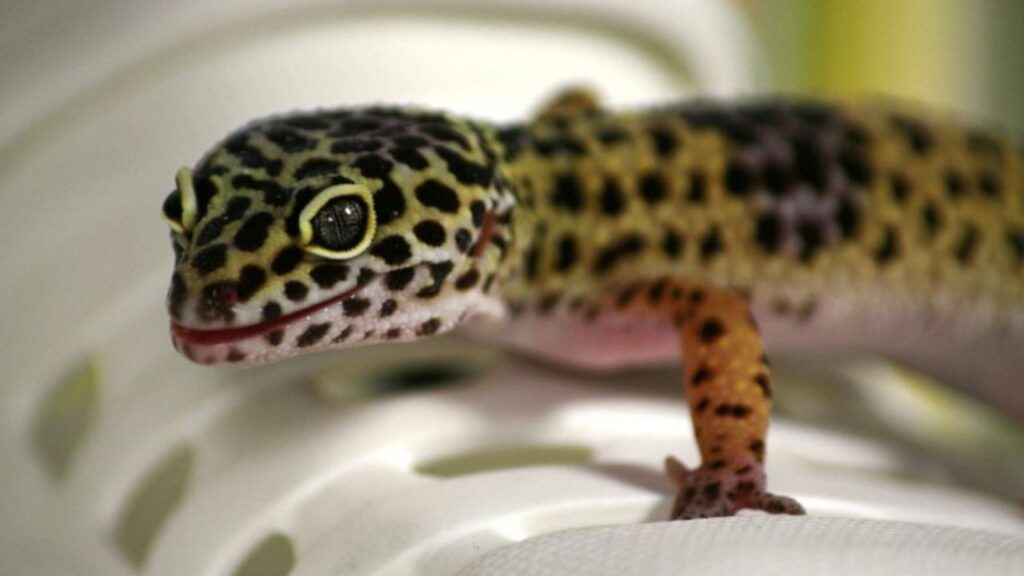Geckos Need a Perfect Climate: Get it Right!
Mastering lighting and heating is vital for your gecko’s health.
Overhead heat sources like halogen bulbs and deep heat projectors simulate natural sun infrared rays. Heat mats, regulated by thermostats, are a great alternative.
Maintain a basking surface temperature of 94-97°F and a warm hide temperature of 90-92°F.
The cool zone should be between 70-77°F, dropping to 60°F at night.
UVB lighting is beneficial, aiming for a UVI of 0.5-1.0, without obstruction.
For nighttime, maintain total darkness and automatic lighting schedules.
Proper environmental control will promote a thriving gecko.
Learn how to achieve the perfect climate for your pet gecko.
Lighting and Heating Options
When it comes to lighting and heating options for Leopard Geckos, selecting the appropriate equipment is essential for their health and well-being.
Halogen bulbs and deep heat projectors are excellent for mimicking the natural infrared rays of the sun, with deep heat projectors offering the advantage of no visible light.
Heat mats, although less natural, remain a viable option when properly regulated with a thermostat.
Overhead heat sources are preferred, as they replicate the gecko’s natural environment. While under-tank heat mats can be used, they are less desirable.
Leopard Geckos can absorb heat from any part of their body, making overhead sources more effective.
Ensuring these options are carefully chosen will promote their digestive health and overall energy.
Temperature Requirements
Proper temperature regulation is essential for the health and well-being of Leopard Geckos.
Maintaining the correct temperature gradients within their enclosure promotes healthy digestion, activity, and overall stamina.
The key temperature requirements for Leopard Geckos are:
- Basking surface temperature: 94-97°F (34-36°C)
- Warm hide temperature: 90-92°F (32-33°C)
- Cool zone temperature: 70-77°F (21-25°C)
- Nighttime drop in temperature: down to 60°F (16°C)
- Temperature cycle fluctuation: mimics natural environment
Providing these temperature ranges helps Leopard Geckos flourish by closely replicating their natural habitat.
Utilize accurate thermometers and thermostats to monitor and regulate these temperatures precisely.
Proper temperature management is a cornerstone of responsible Leopard Gecko care.
UVB Lighting
While maintaining ideal temperature is fundamental for Leopard Gecko health, providing UVB lighting can greatly enhance their overall well-being. UVB lighting supports natural behaviors and physiological processes, contributing to a thriving gecko. Although Leopard Geckos can survive without UVB if given dietary D3 supplements, incorporating UVB lighting is recommended for peak health.
| Factor | Recommendation | Note |
|---|---|---|
| UV Index (UVI) | 0.5 – 1.0 | Verify proper distance from the bulb |
| Bulb Placement | Unobstructed by glass/plastic | Direct exposure is vital |
| Sensitivity | Special care for albino geckos | Provide adequate retreats from UV light |
Incorporating UVB lighting guarantees Leopard Geckos receive benefits akin to their natural environment.
Nighttime Care
Nighttime care for Leopard Geckos necessitates creating an environment that respects their natural circadian rhythm and crepuscular activity patterns.
Proper nighttime care involves creating an environment that simulates their natural habitat, which helps reduce stress and maintain health.
Avoid using night lights, as reptiles can detect light from red and blue colors, potentially disrupting their sleep cycles.
Instead, consider using automation systems to manage light schedules.
Provide total darkness at night to mimic natural conditions.
Avoid using red or blue night lights to prevent disruption of circadian rhythms.
Utilize timers or automation systems to regulate lighting schedules.
Maintain a nighttime temperature drop, down to 60°F (16°C), for natural environmental simulation.
Regularly monitor and adjust nighttime temperatures to guarantee comfort and health.
Conclusion
Creating a suitable habitat for Leopard Geckos involves careful attention to their lighting and heating requirements.
Utilizing appropriate lighting options, such as halogen bulbs and UVB lighting, alongside effective heating methods like heat mats, fosters a healthy environment.
Maintaining natural light cycles is essential for their nocturnal habits and circadian rhythms.
By adhering to these guidelines, reptile enthusiasts can guarantee the well-being and vitality of Leopard Geckos, promoting their overall health and longevity.
